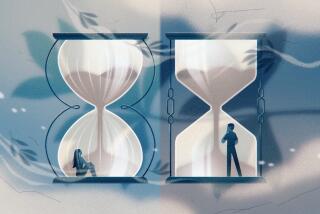Gender Gap Seen in How Men Perceive Health Needs
- Share via
NEW YORK — A Texas otolaryngologist has noted an interesting difference between the men and women who seek help in his Galveston office.
“It’s very common for older women to come in and say they have a problem with their hearing and for the men to come in and say, ‘My wife thinks I have a problem with my hearing,’ ” Dr. Byron Bailey said in a recent interview.
“It’s as if women are more likely to notice warning signs of ill health, both in themselves and in others,” he said.
Bailey’s experiences may be indicative of a dangerous discrepancy in the United States between how men and women perceive and seek health care, according to a Missouri researcher.
Ann Rosenow, a professor of nursing at the University of Missouri in Columbia, has spent several years researching health issues surrounding men after finding an abundance of literature on the health concerns of women.
She cites statistics that are familiar, but still startling.
Women will, on average, live seven years longer than men. And a survey of 13 industrialized countries showed the United States ranks eighth in life expectancy for women but ranks 12th for men.
Biological Differences
Rosenow said biological differences may account for a two- or three-year gap between the life expectancies of men and women.
“But the remainder is due to differences in life styles and environments,” Rosenow said. “It’s a cultural thing.”
By the year 1990, she said, the discrepancy between male and female longevity is expected to increase to nine years.
“In 1900 there were 96 men to every 100 women who were 75 years or older,” she said. “The projection for 1990 is 54 men to every 100 women in that age category.”
Rosenow said, and a number of health officials agreed in separate interviews, that men are less likely to seek medical care, are less aware of warning symptoms of disease and are less prone to take preventive health measures such as eating nutritious foods and exercising regularly.
Most women, on the other hand, are fairly knowledgeable about health issues, especially if they are of childbearing age, the health specialists said.
“Most birth control is still in the woman’s hands, which means an annual visit to the doctor,” Rosenow said. “They learn about healthier life styles and preventive measures.”
Barrage of Information
Dr. Harry Metcalfe, president of the American Academy of Family Physicians, agrees that women are bombarded with information from the media and their health care facilities about reproduction, birth control, breast cancer and osteoporosis, a bone disease that primarily affects older women.
He noted most women know how to perform periodic self-examinations for breast cancer but that few men know they should perform frequent self-examinations for testicular cancer, or know how to do so.
“Women use the system more,” he said. “They are the child bearers and they are usually the ones who take the children to the doctor. They are more apt to be dealing with physicians.”
Metcalfe said his own organization’s advertising campaign targets women between the ages 30 and 45 because studies show they are the major purchasers of health care, not just for themselves but for the whole family.
The group’s ads are prominent in women’s magazines, but not in magazines usually read by men, he said.
“Education is probably the key to changing attitudes,” he said. “But it is a slow process.”
Rosenow said studies have shown that men are not only less likely to note warning symptoms of disease, but they are much more likely to be injured or die
violently.
“Men tend to engage in leisure-time pursuits that are more hazardous, such as auto racing or hunting,” she said. “They tend to work in more dangerous occupations, such as construction work or with toxic chemicals.”
However, Bailey, who noted huge discrepancies between his older male and female patients, finds fewer and fewer differences in his younger patients.
“The difference is much less striking in the young people,” he said. “The men, if they can afford it, belong to these health clubs. They are much more up on their knowledge of health problems, much more well-read.”
More to Read
Sign up for Essential California
The most important California stories and recommendations in your inbox every morning.
You may occasionally receive promotional content from the Los Angeles Times.













